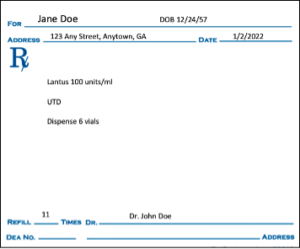Educating your Pharmacy Network for Audit Preparedness
Pharmacies have always been a critical access point for healthcare information. A pharmacist is ever available to patients and offers free healthcare advice, thereby increasing access to the medical system at a decreased cost. During the COVID-19 pandemic, the federal government has recognized pharmacies as a critical touch point for medical care in the community and has issued a new scope of practice to pharmacists to help their communities during these tough times.¹
Furthermore, audit mandates via CMS and PBMs (Pharmacy Benefit Managers) continue to require some oversight via pharmacy audit. To ensure that the pharmacy operates following state and federal pharmacy standards, audits may consist of a comprehensive desktop audit or even a visit to the pharmacy to conduct an onsite audit. The difference between the two is that desktop or ‘desk audits’ are done in-house via requesting copies of prescriptions, whereas onsite audits involve a physical review of the pharmacy and prescriptions at the dispensing site. The auditor creates an audit report in either scenario, which outlines any discrepancies identified during the audit. The following are just a few of the many types of violations (discrepancies) that may be discovered during a pharmacy desk audit:
-
- No date on prescription
- Incorrect use of DAW code
- Undocumented substitution
- Billed brand and dispensed generic
- Missing/Invalid Prescriber Documentation
- Missing/Invalid Patient Documentation
- Different drug billed and/or dispensed than written on the prescription
- Incorrect NDC # billed
- Duplicate Claim Billed
- The prescription was not picked up/delivered or shipped within 14 days of the fill date (the number of days may vary by pharmacy claims processor)
- Missing/Invalid signature log/proof of delivery
- Incorrect documentation submitted (Prescription and signature log)
- Refill too soon
- Unauthorized/Undocumented Refill of Prescription
- Prescription lacks specific, calculable directions (use as directed or missing directions)
Pharmacy Analysis Reveals Pharmacy Audit Trends
The Codoxo pharmacy analyst team conducted a holistic trend analysis of our audit activity to determine which pharmacy audit discrepancies occurred the most. After review, the two (2) most common discrepancies are:
- Unclaimed Prescriptions (Prescription was not picked up/delivered or shipped within a certain number of days of fill date)
- Prescription lacks specific, calculable directions (use as directed or missing directions).
Unclaimed Prescriptions
Unclaimed prescriptions are those that have not been shipped to the patient or have not been claimed by the patient within a specific time frame. Some of the causes for this may include the authorizing physician sending the prescription to the incorrect pharmacy, the patient assuming no need for the medication, drug/therapy regimen changes, or it may be cost-related.
As illustrated in the process flow below, a standard pharmacy transaction includes the following:
-
- The doctor or clinician sends a prescription order to the pharmacy for a patient who seeks medical care.
- The pharmacy fills and prepares the order.
- The patient then is dispensed the medication (via patient pickup, delivery or shipment).
What happens if the medication does not get picked up or shipped within a specific time frame?
Based on the pharmacy’s contract agreement with the pharmacy claims processor (typically pharmacy benefit managers or ‘PBMs’), the pharmacy must arrange a pickup or shipment with the patient or caregiver within a certain number of days. This time frame is usually 14 calendar days but may vary based on the PBM.
If the prescription goes unclaimed, the pharmacy is obligated to reverse the prescription claim via the Point of Sale (POS) system and return the medication to stock. Any prescription claims picked up or shipped after the 14 calendar days are subject to recoveries and may yield overpayments as this may be a direct violation of the pharmacy contract/agreement.
Codoxo’s Recommendation: Unclaimed Prescriptions
-
- Work with your pharmacy claims processor and request a copy of the pharmacy manual. The pharmacy manual should specify how many calendar days in which the patient must pick up the medication before the pharmacy reverses it and returns it to stock.
- When requesting prescription records from the pharmacy, ask for the signature log or courier shipping tracking information. The signature logs and tracking information should include the date of when the transaction took place.
- Compare and calculate the number of days between the signature log date/shipping date and the filled date of the claim.
Prescription Lacks Specific, Calculable Directions (Use as Directed or Missing Directions)
Prescriptions that lack calculable directions are prescriptions where there are no directions or the directions are incomplete from the prescriber. The prescriber will often write “Take as Directed” (UTD). The prescriber will leave out the information required to calculate the correct quantity to bill, such as frequency, the affected area, patient weight, max daily dose or duration of treatment.
What are some common types of medication classes identified with this discrepancy?
Some of the common types of medications that have this discrepancy include:
-
- Insulins
- Creams
- Ointments
- Lotions
- Infusions
- Anticoagulants
- Eye Drops
- Otic Solutions/Suspensions
- Inhalers
- Nasal Sprays
- Titrated Medications
- Liquid medications for Pediatric patients
- Pain medications
- Anti-Migraine medications
What are some things that I should look for surrounding prescriptions that lack calculable directions?
One should look for the following:
- Common medication classes billed for multiple or excessive packages billed
- Common medication classes are billed for a smaller day supply than customary, and the frequency varies.
- Medications where the dosing is calculated based on patient weight

Significant Financial Impact: Over or Underbilling the Medication
As a result of this discrepancy, the pharmacy may be overbilling or underbilling the medication. If the pharmacy dispenses more medication than is allowed or is required, this may result in early refills or the pharmacy not collecting the correct copayment from the patient. It also results in waste, mainly if a lower day supply is submitted and the pharmacy has it on auto-refill.
If the patient is unaware of how to take the medication, the pharmacy label will provide no help and may confuse the patient. This could result in the patient taking the medication incorrectly and lead to patient harm.
Codoxo’s Recommendation: Prescription Lacks Specific, Calculable Directions (Use as Directed or Missing Directions)
This discrepancy is very common, and it is best to educate the pharmacies to avoid these issues. The pharmacy manual should include what information needs to be on the prescription to properly calculate the dose. If the prescriber does not include sufficient directions or if they are not clear, advise the pharmacy to reach out to the prescriber’s office to get clarification. Also, it is recommend to include how to correctly document the changes made to the prescription in the manual. Any changes not properly documented will not be used during the audit process.
If a high number of these errors are found at a pharmacy during an audit, Codoxo recommends reauditing that pharmacy at a later date (date determined by the contract), to see if they have corrected the issues.
Summary:
The increasing workplace challenges inflicted on community-pharmacy personnel in the wake of COVID-19 places this valuable human resource at increased risk of burnout. Professional pharmacy organizations have acknowledged this risk and have developed resources to improve well-being and resilience during this unprecedented time.²
Educating your pharmacy network proactively helps to reduce the burden on this already overwhelmed team of healthcare practitioners. The practice of pharmacy audit is necessary, but some discrepancies can be avoided with proper education of both pharmacies and prescribers.
1,2 U.S. Pharmacist, May 14, 2021: Challenges in Community Pharmacy During COVID-19: The Perfect Storm for Personnel Burnout
If you are interested in learning more about Codoxo’s forensic AI platform or would like to speak to Codoxo team member, contact us via info@codoxo.com.
